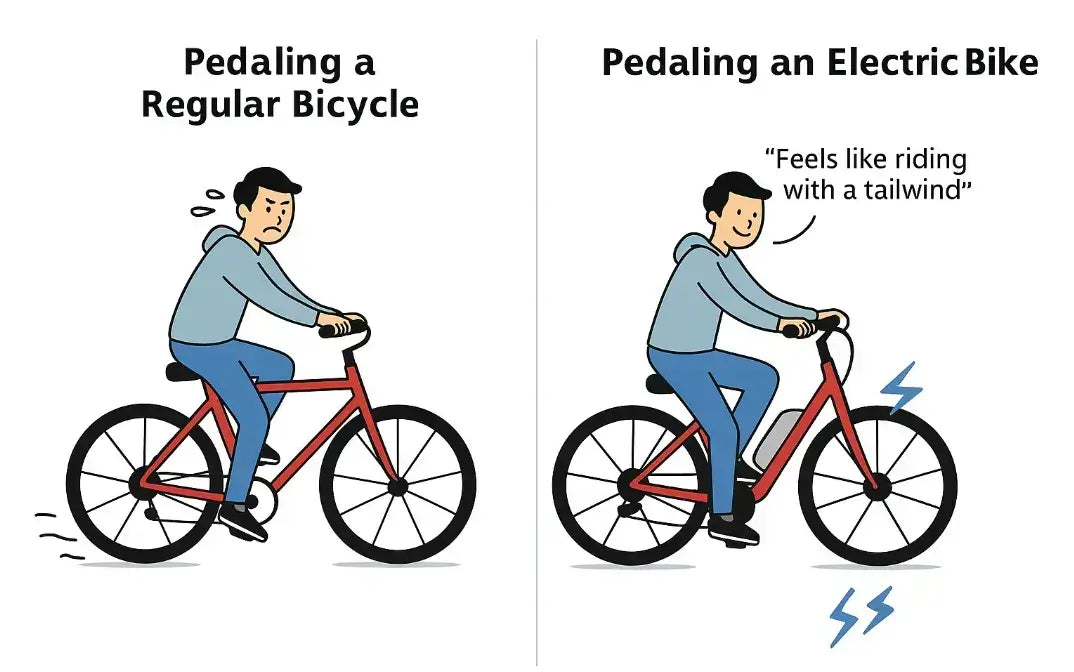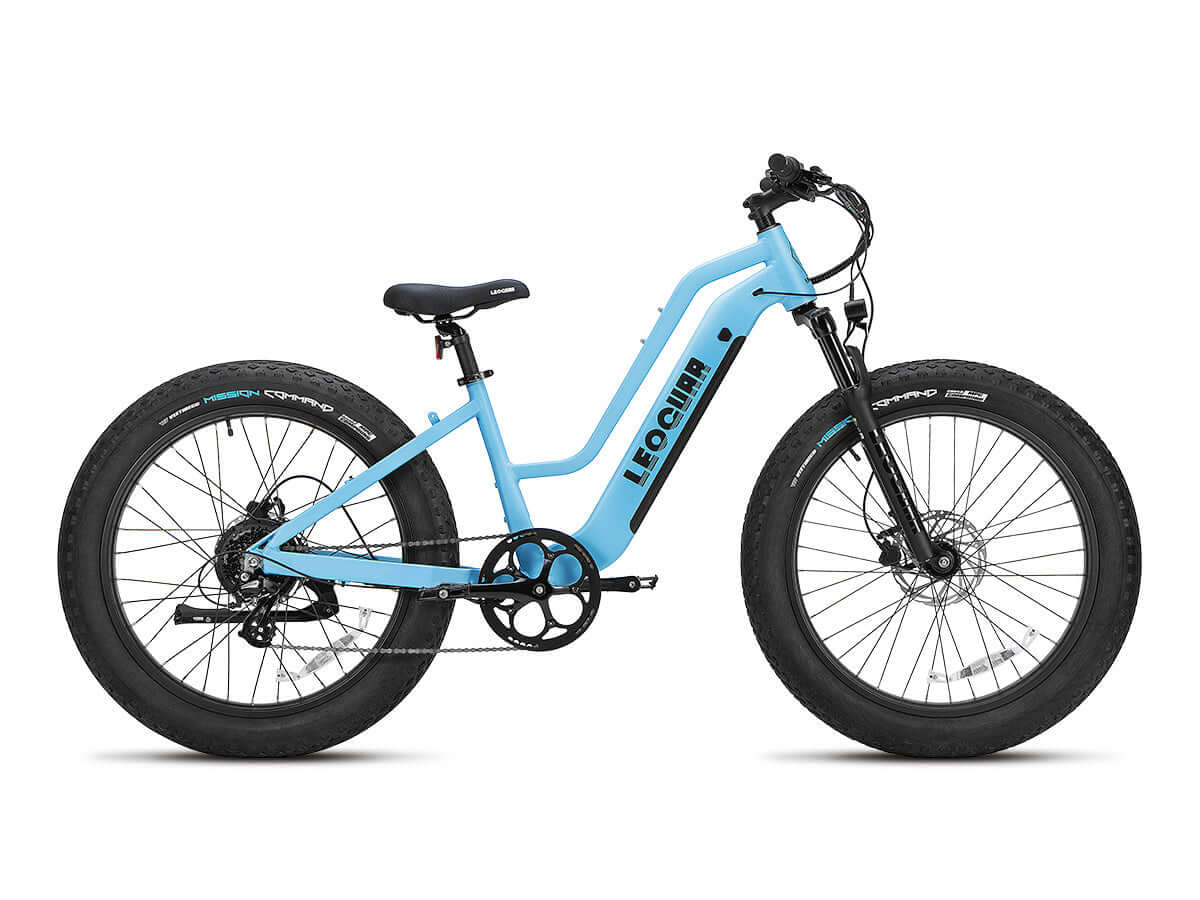
Types of Bikes: Ultimate Guide to E-Bikes & Traditional
Stepping into the world of cycling can feel like walking into a library with a million books and no guide. The huge number of different kinds of bikes is overwhelming. But finding the right one doesn't have to be hard. The secret is to make the process simple. This guide will help you do that by cutting through the confusion to give you a clear path to your perfect bike. We'll start by tackling the most basic choice in modern cycling: deciding between a regular bike and an electric bike. From there, we'll look at the main types of bikes for every kind of terrain and finish with a simple plan to help you choose with confidence.
E-Bike or Regular?
The biggest decision you'll make today isn't about brand or color—it's about power. Do you want a bike powered only by you, or one that gives you an electric boost? This choice sets the foundation for everything else.
An electric bike, or e-bike, is a bicycle with a built-in battery and motor that helps your pedaling. It's not a motorcycle or a scooter; you still have to pedal, but the motor makes your effort stronger. A regular bike, sometimes called an "acoustic" bike by fans, is the classic, human-powered machine you already know.
The e-bike revolution is real. As a green and easy form of transport, their popularity has grown, a trend confirmed by recent industry analysis from Deloitte. But is one right for you? Let's compare them side by side.
| Feature | E-Bike | Regular Bike |
|---|---|---|
| Effort & Access | Makes hills and long rides much easier. Makes cycling possible for a wider range of fitness levels. | Powered entirely by your effort. Gives a more steady and demanding physical workout. |
| Speed & Range | Lets you keep higher average speeds with less effort, extending how far you can go. | Speed and range are directly tied to your physical fitness and the terrain. |
| Cost | Higher cost upfront. Quality models start around $1,000 and can go over $10,000. | More affordable upfront. Quality entry-level bikes start around $500-$800. |
| Weight & Moving | Much heavier (40-70+ lbs) because of the motor and battery. Hard to carry up stairs or lift onto racks. | Much lighter (15-35 lbs). Easy to carry, lift, and store. |
| Care | Needs all the same care as a regular bike, plus special care for electronic parts. | Simpler and less expensive to maintain. Any bike shop can service it. |
| Fitness Benefit | Still gives a great workout, but lets you control how hard it is. You'll likely ride farther and more often. | An excellent heart workout. The intensity depends on your pedaling and the terrain. |
Core Categories by Terrain
Once you've leaned toward either electric or regular, the next step is to match your bike to where you'll be riding. Most bikes fall into one of three main families, each designed for a specific environment. As you read, remember that an e-bike version exists for almost every category, offering the same features with an added boost.
Road Bikes for Speed
- Best For: Speed, fitness, and long-distance riding on smooth, paved roads.
-
Key Features:
- Light frames for efficiency and easy acceleration.
- Thin, high-pressure tires that reduce rolling resistance.
- Dropped (curved) handlebars that put the rider in an aerodynamic and powerful position.
- The E-Road Bike: This is your secret weapon against headwinds and steep climbs. It allows riders to go farther than ever before, explore more challenging routes, or simply keep up with a faster group of friends without getting left behind.
Mountain Bikes for Trails
- Best For: Off-road adventures on dirt paths, single trails, and rough, unpaved terrain.
-
Key Features:
- Strong, tough frames built to handle abuse.
- Suspension systems (on the front fork or both front and rear) to absorb bumps and improve control.
- Wide, knobby tires that provide great grip and traction on loose surfaces.
- Flat, wide handlebars for maximum steering power and control.
- The E-MTB: An electric mountain bike changes the experience. It makes the tough climbs, which are often just a way to get to the fun part, much easier and faster. This saves your energy for the best part: going downhill. It opens up access to more terrain for more people, as confirmed by many expert guides to different bike types.
Hybrid Bikes for Versatility
- Best For: Casual riding, city commuting, and fitness on a mix of pavement and light, smooth trails.
-
Key Features:
- A balanced blend of road and mountain bike features.
- A more upright and comfortable riding position than a road bike.
- Tires that are wider than a road bike's for comfort and stability, but smoother than a mountain bike's for efficiency on pavement.
- The E-Hybrid Bike: This is arguably the ultimate car-replacement vehicle. It makes daily commutes sweat-free, turns grocery runs into a joy, and makes carrying kids or cargo easy. It's the go-to choice for practical, everyday transportation.
Special Types of Bikes
Beyond the big three, a fascinating world of special bikes exists to serve specific needs. These show the incredible variety within the basic bicycle categories and might be the perfect fit for your unique lifestyle.
- Gravel Bikes: The adventurous cousin of the road bike. They combine the speed of a road bike with the strength and wider tire space of a mountain bike, making them perfect for tackling a mix of pavement, dirt roads, and light trails in a single ride.
- Touring Bikes: These are the long-haul trucks of the cycling world. Built for multi-day, self-supported journeys, they feature ultra-stable frames, a comfortable riding position, and countless mounting points for racks and bags to carry all your gear.
- Folding Bikes: The ultimate solution for commuters with limited storage or a multi-step commute. These bikes fold down into a small package, perfect for taking on a train, hiding under your desk, or storing in a small apartment.
- Cargo Bikes: Designed specifically to haul heavy or bulky loads. With long wheelbases and sturdy frames, they can carry everything from a week's worth of groceries to multiple children. Electric cargo bikes have become especially popular, making heavy loads feel weightless.
- Cruiser Bikes: The perfect example of relaxed, stylish cycling. Built for comfort above all, cruisers are perfect for easy rides around the neighborhood or along the beach boardwalk. They feature wide handlebars, comfortable seats, and a laid-back vibe.
A 4-Step Plan
All this information is great, but how do you apply it to you? Let's put it all together with a simple, four-step plan to turn knowledge into a confident decision.
Step 1: Where Will I Ride?
Your main terrain is the most important factor. Be realistic about where you will spend 80% of your time.
- Mostly smooth pavement, bike paths, and roads? Start by looking at Road and Hybrid bikes.
- Mostly dirt trails, forests, and rough paths? Your search begins and likely ends with Mountain Bikes.
- A bit of everything—city streets, gravel paths, and paved trails? This is the sweet spot for Hybrid and Gravel bikes.
Step 2: Why Will I Ride?
Your purpose will narrow the choices further. As noted in a complete bike buying guide, matching the bike to the goal is key.
- For fitness, speed, and long-distance challenges? A Road Bike is made for this.
- For commuting to work or running errands? A Hybrid, Folding, or E-Bike is your best bet for practical use.
- For pure fun and casual weekend rides? A Hybrid or Cruiser offers the most comfort and enjoyment.
- For hauling kids, groceries, or gear? A Cargo Bike is built for the job.

Step 3: Be Honest About Yourself
This is where you think about your fitness, comfort, and budget. It's also the final checkpoint for the e-bike decision.
- Fitness & Terrain: Do steep hills scare you or limit your routes? Do you want to ride for longer without being exhausted? Do you need to arrive at your destination without being covered in sweat? If you answered yes to any of these, an e-bike will completely change your relationship with cycling for the better.
- Budget: As we established, regular bikes have a lower entry cost. E-bikes require a larger initial investment. Set a realistic budget, but also think about the value an e-bike might bring in terms of replacing car trips or enabling more frequent riding.
Step 4: The Test Ride
You can read a hundred articles, but nothing replaces firsthand experience. This step is a must. A bike that looks perfect on paper might not feel right when you're on it. The geometry, the handlebar position, and the overall feel are deeply personal. Visit a local bike shop, talk to their experts, and test ride a few different models from the categories you've identified. Feel how a hybrid compares to a road bike. If you're curious about e-bikes, try one—the smile-inducing boost is something that has to be felt to be understood.
Final Thoughts
Choosing a bike is a journey of self-discovery. By breaking the decision down—first power, then terrain, then purpose—you can move from feeling overwhelmed to feeling empowered. Don't get lost searching for the single "best" type of bike. The best bike is the one that fits your life, meets your needs, and, most importantly, gets you excited to get out and ride.
Frequently Asked Questions
Q: How much should I spend on my first bike?
A: For a quality traditional bike, budget $500-$800 for entry-level models. E-bikes start around $1,000 for decent quality. Remember that a good bike is an investment that will last for years with proper care.
Q: Can I ride an e-bike in the rain?
A: Yes, most e-bikes are designed to handle light rain and wet conditions. However, avoid riding through deep puddles or heavy downpours to protect the electrical components. Always check your specific bike's water resistance rating.
Q: Do I need special gear or clothing to start cycling?
A: The only essential item is a properly fitted helmet. Comfortable clothes and closed-toe shoes are fine for casual riding. As you ride more, you might want padded shorts, cycling gloves, or moisture-wicking shirts for comfort.
Q: How do I know if a bike fits me properly?
A: A properly fitted bike allows you to reach the handlebars comfortably without stretching, and you should be able to touch the ground with your toes when seated. Most bike shops offer free fitting services when you purchase a bike.
Q: What's the difference between different types of bikes in terms of maintenance?
A: All bikes need basic maintenance like tire pressure checks and chain lubrication. Mountain bikes may need more frequent cleaning due to dirt exposure. E-bikes require the same basic care plus occasional battery maintenance and software updates.









































Leave a comment